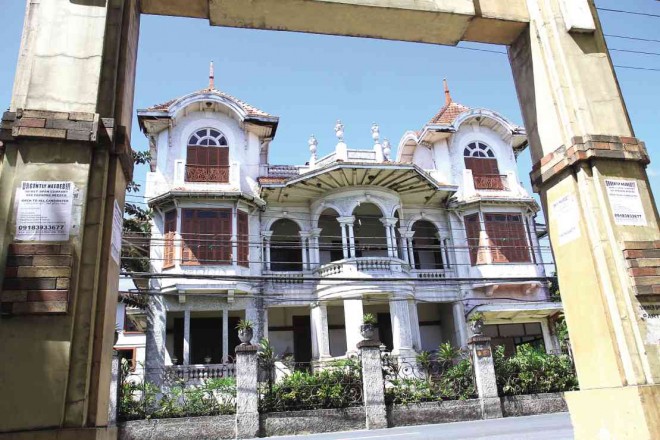NCCA asked to stop vehicle loading bay at Sariaya plaza

STRONG opposition by heritage protection advocates saved this antique house from damage. DELFIN MALLLARI JR./INQUIRER SOUTHERN LUZON
RESIDENTS of Sariaya town in Quezon province have asked the National Commission for Culture and the Arts (NCCA) to permanently stop the construction of a vehicle loading bay at the town plaza, which they said would further ruin the vista of the monument of national hero Dr. Jose Rizal and harm heritage buildings around the area.
The NCCA last month stopped the construction of several bus and vehicle loading bays along parts of Daang Maharlika in the town proper—a project of the Department of Public Works and Highways.
The construction of the loading bays and the presence of vehicles would also cause vibrations harmful to old buildings and heritage houses around the plaza, said Rina Marquez, a resident who lives across the plaza, who has secured the cease-and-desist order (CDO) on the project from the NCCA.
Marquez represents her family as the stakeholders of the Natalio Enriquez House, residence of a prewar provincial governor and one of the few remaining structures designed by renowned architect Andres Luna de San Pedro. The twin-spired, brick-roofed mansion was declared a heritage house by the National Historical Institute (now the National Historical Commission of the Philippines) in 2008.
She told the Inquirer over the phone that heritage specialists had determined that vibrations from construction equipment and parked vehicles would damage the St. Francis of Assisi Parish Church as well as other heritage structures including the municipal hall, an Art Deco building designed by renowned architect Juan Arellano.
Article continues after this advertisementThe town plaza and park, which is next to the municipal hall and across the church and Enriquez mansion, holds the Rizal Monument which was inaugurated on Rizal Day, Dec. 30, 1924.
Article continues after this advertisement“I heard recently that the old bridge in Tayabas [town], which is one of the oldest bridges in the country, got damaged by vibrations from a nearby project. Let’s keep in mind that the Sariaya church was built in the 1700s. Having been there for centuries, it’s foundations have been going through a lot of wear and tear,” Marquez said.
The loading bay on the plaza would also further ruin the view of the Rizal Monument, which had suffered when a covered court was built beside it in the 1990s and “covered” the view of several ancestral houses surrounding the plaza.
“The area that is left around the Rizal Monument is small enough. We cannot afford to lose any more space … more importantly, Sariaya is one of the few remaining places where the original streetscape is still intact. This alone is of great significance. We need to protect and preserve this for our sake and for our children’s children,” Marquez said.
In a letter sent last week to NCCA Chair Felipe de Leon Jr., Marquez said residents were very thankful for the CDO “but at the same time, the fight continues [against] blatant disregard and disobedience to [cultural protection laws which] will not cease until we do something more permanent to protect the heritage structures and streetscapes of Sariaya.
Marquez said a team from the University of the Philippines College of Architecture, which conducted a study on Sariaya in 2008, submitted plans and designs to rehabilitate the plaza but these had not been acted upon by authorities.
“Until this day, we are waiting and hoping for improvements, starting with relocating or renovating the cement covered court (so aptly named) so that it will no longer ‘cover’ the heritage houses,” she recounted.
During the first hearing held by the NCCA last April, Marquez said she and other heritage advocates, explained to DPWH Quezon local engineers that the best option would be to adjust the agency’s plan and move the loading/unloading bay before or after the heritage cluster so as not to damage the heritage structures.
However, in the second hearing last month, the DPWH and the Sariaya administrator refused to consider the damage they would cause to the structures.
“We and other heritage advocates and stakeholders are not opposed to a loading bay as long as the location is outside of the heritage cluster—composed of the church, municipio, Rizal Monument, plaza and ancestral houses—and away from any important cultural property/structure. This is also in compliance to the National Cultural Heritage Act, the Cultural Properties Preservation and Protection Act, and even the Local Government Code,” she said.
A notice says NCCA hearing officer Ahmed Paglinawan would conduct a conference in Sariaya tomorrow with government agencies, conservationists and other sectors to discuss ways to settle the dispute. Jerome Aning